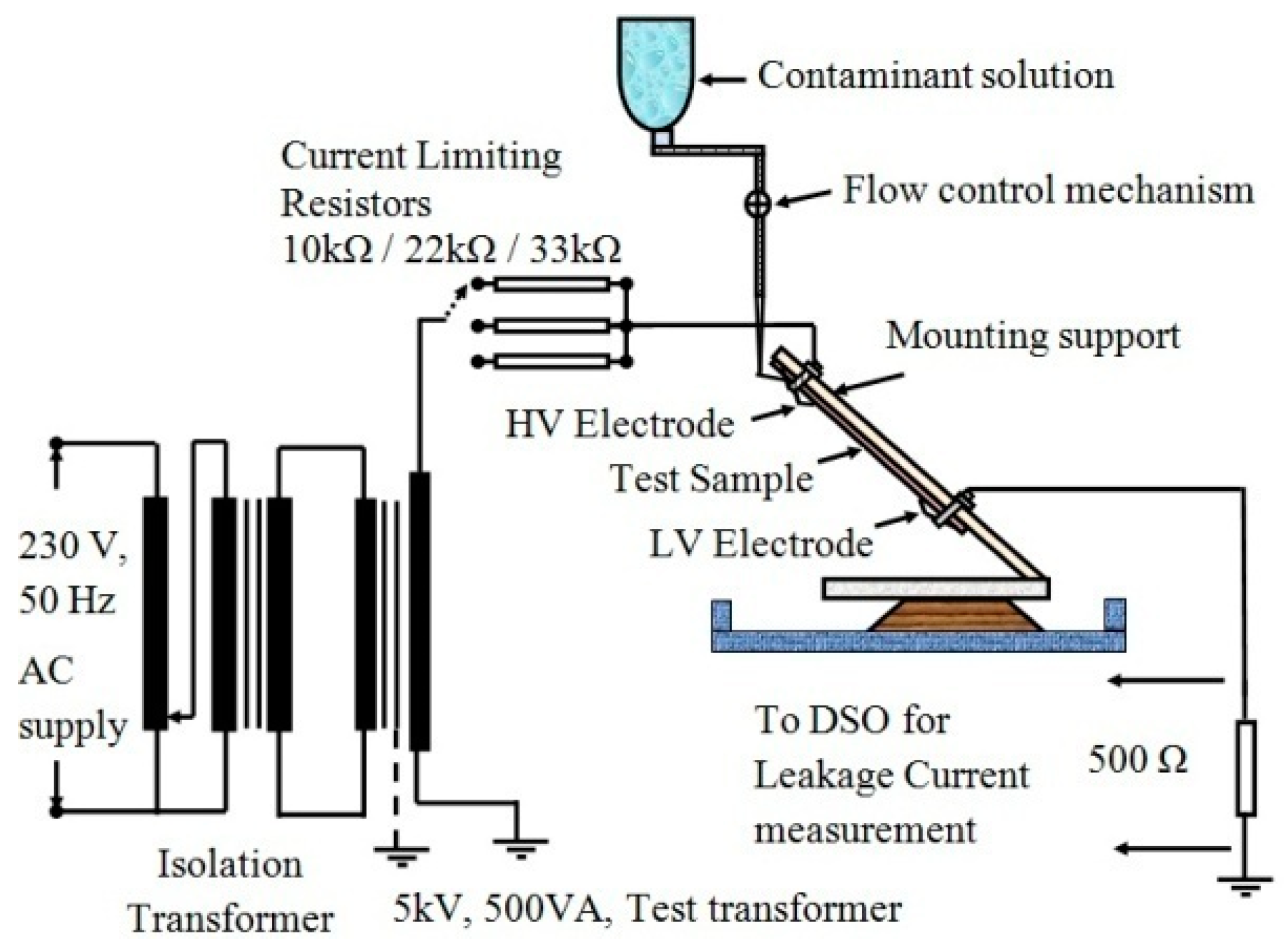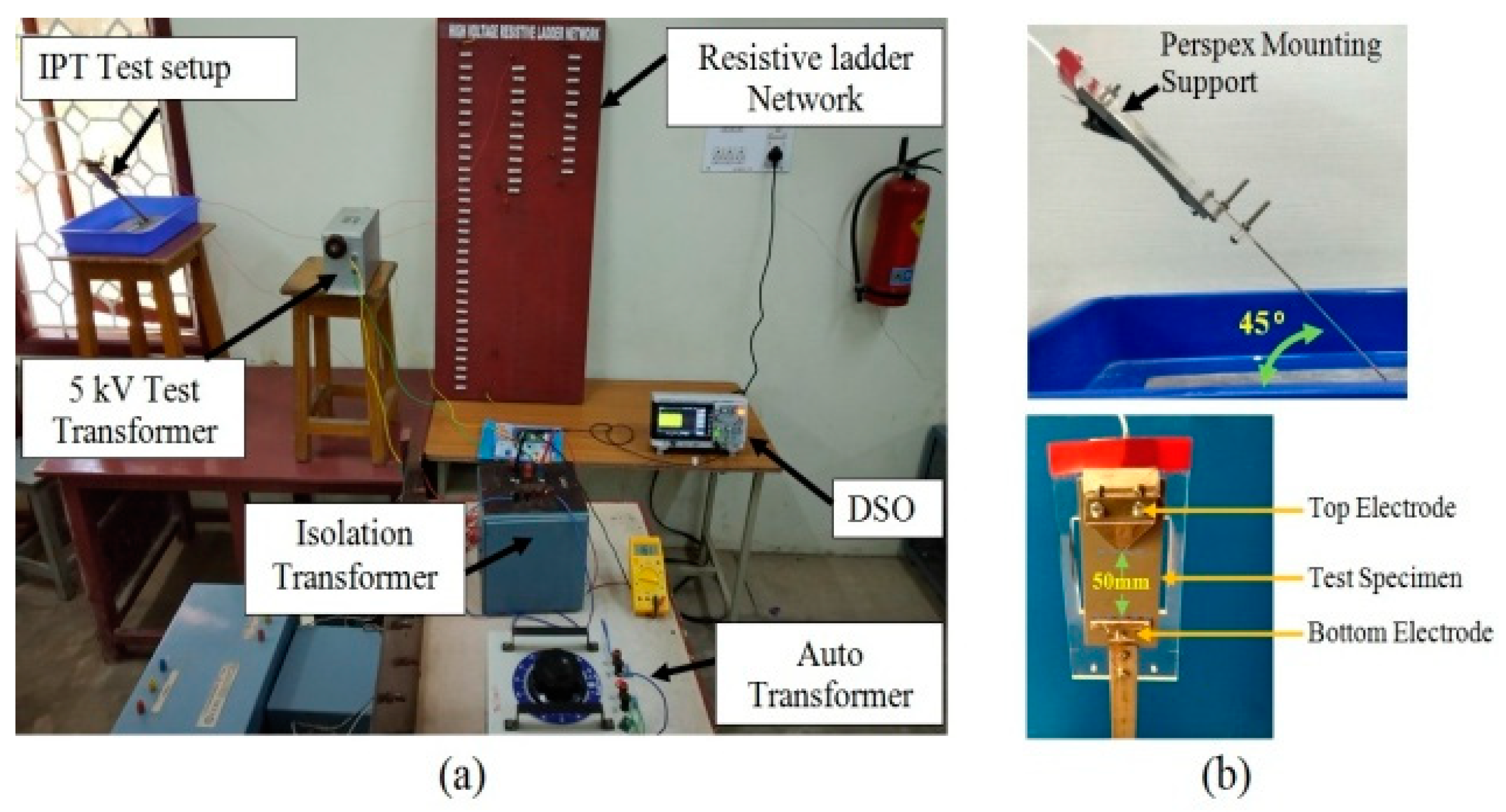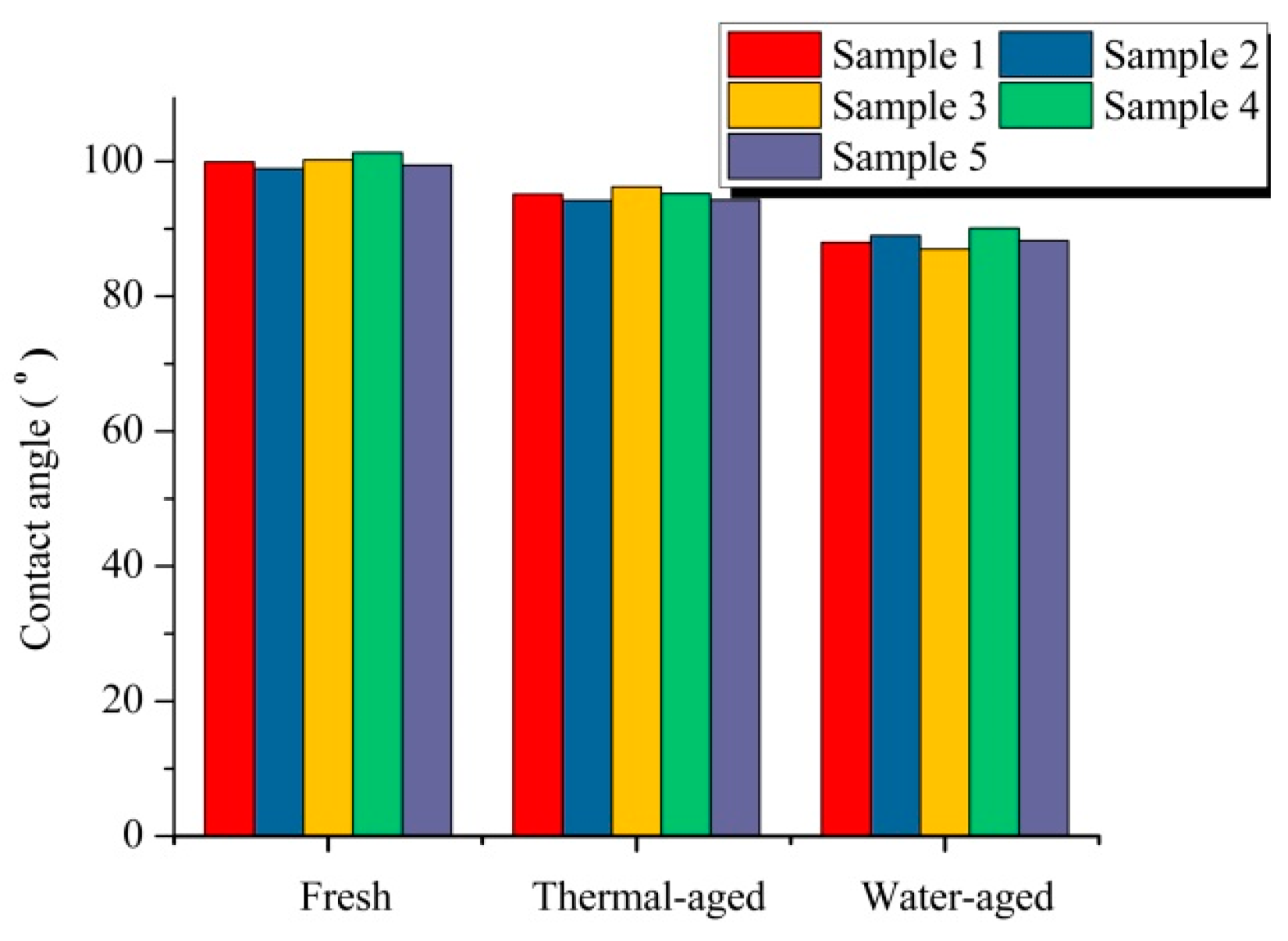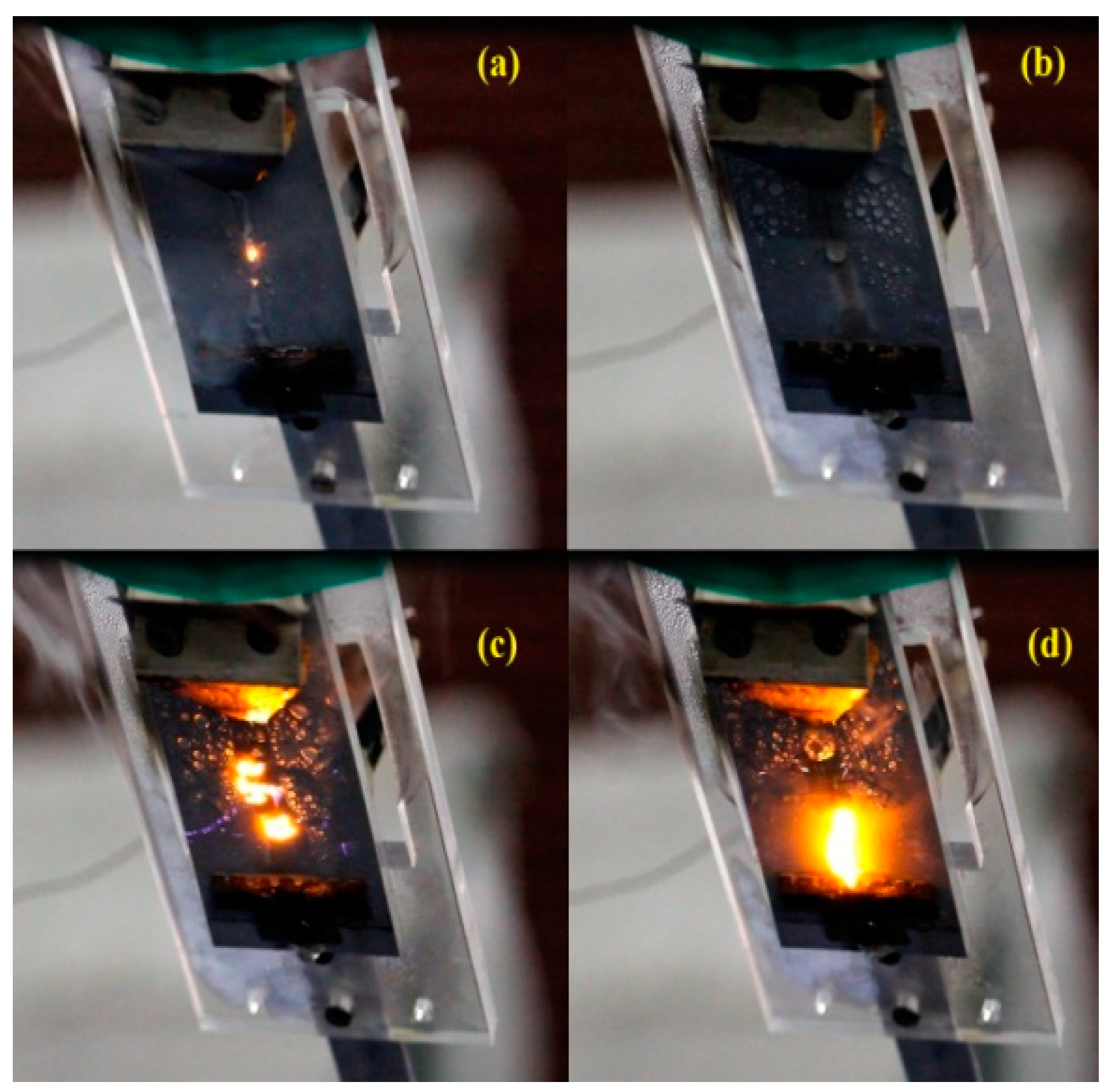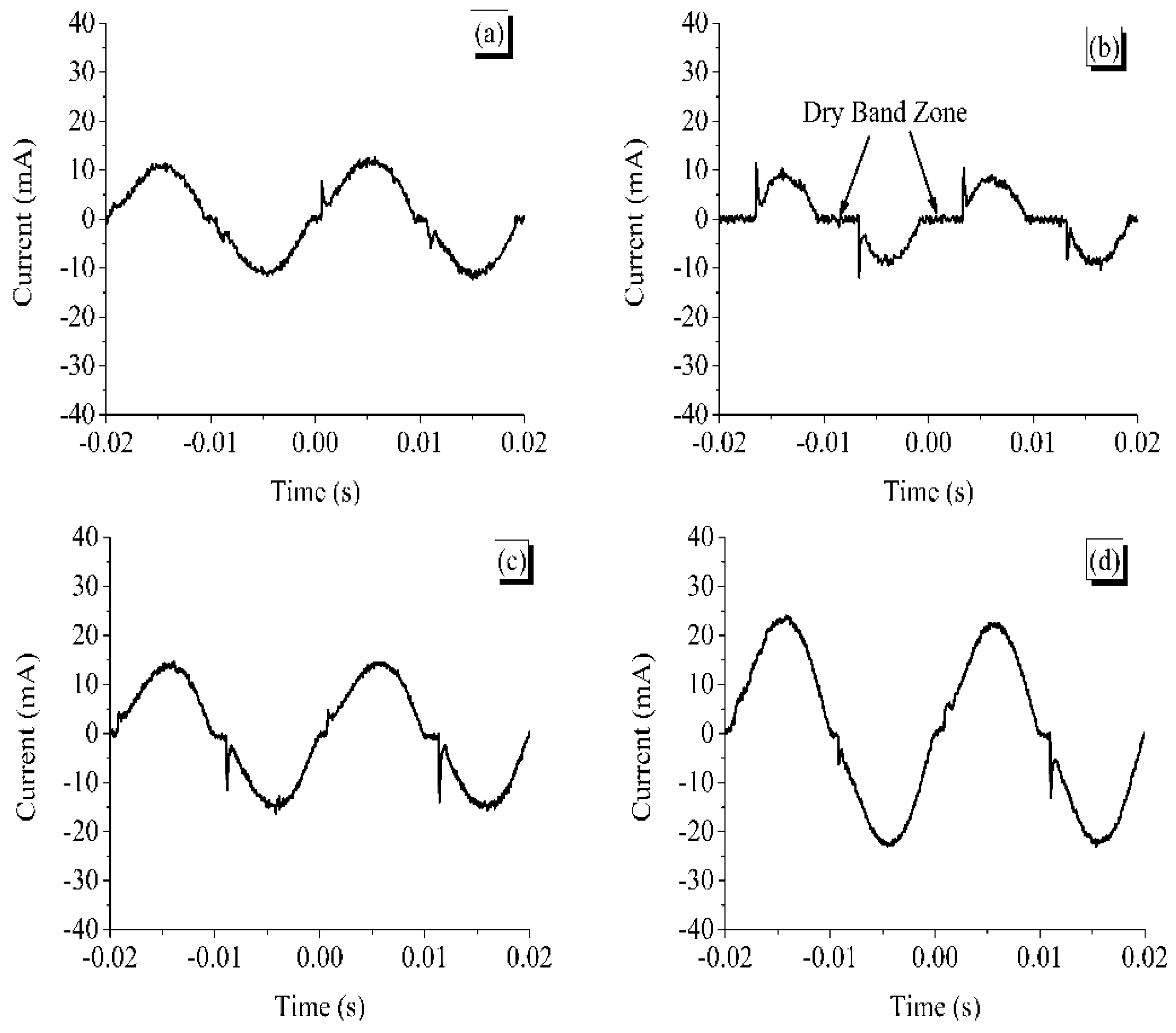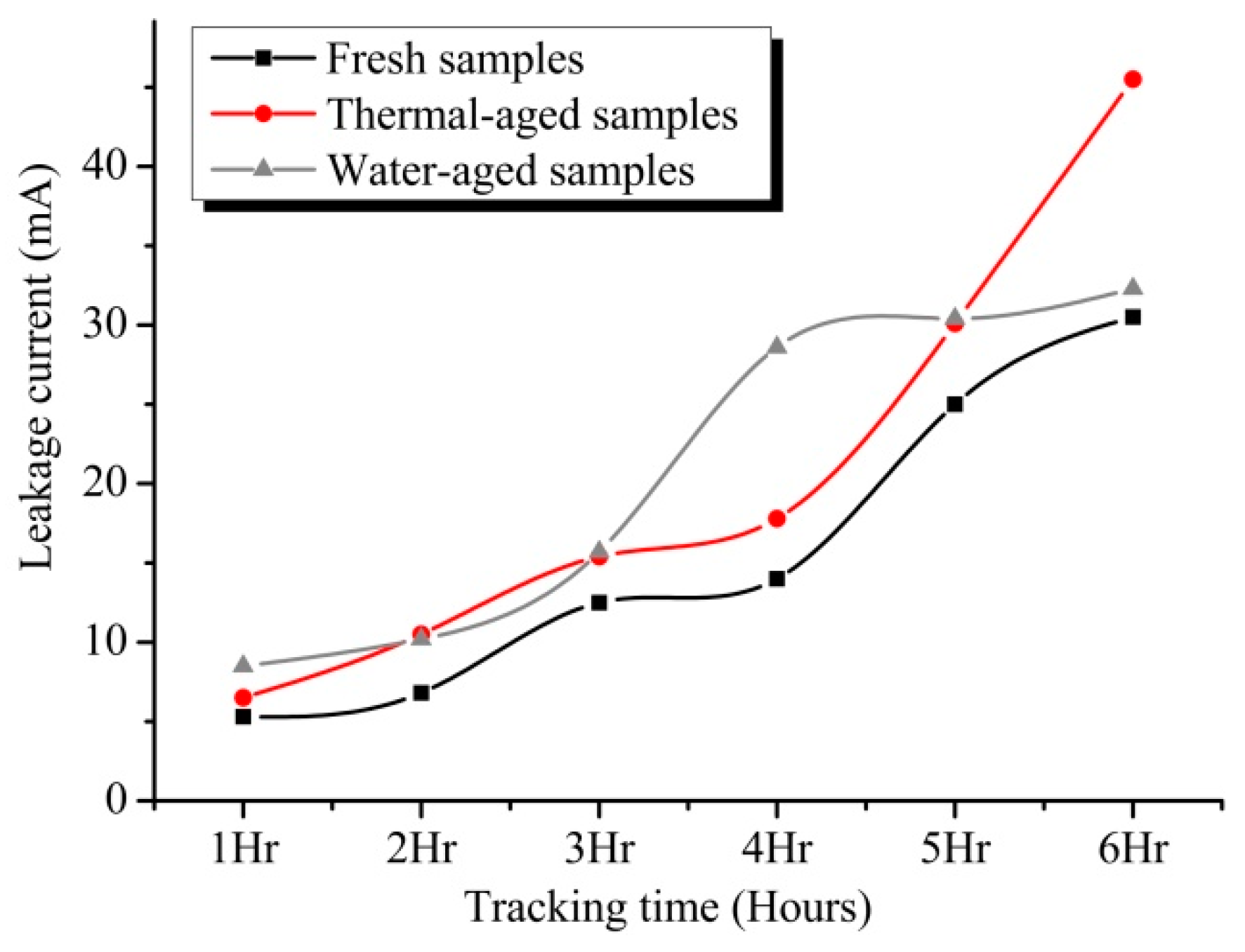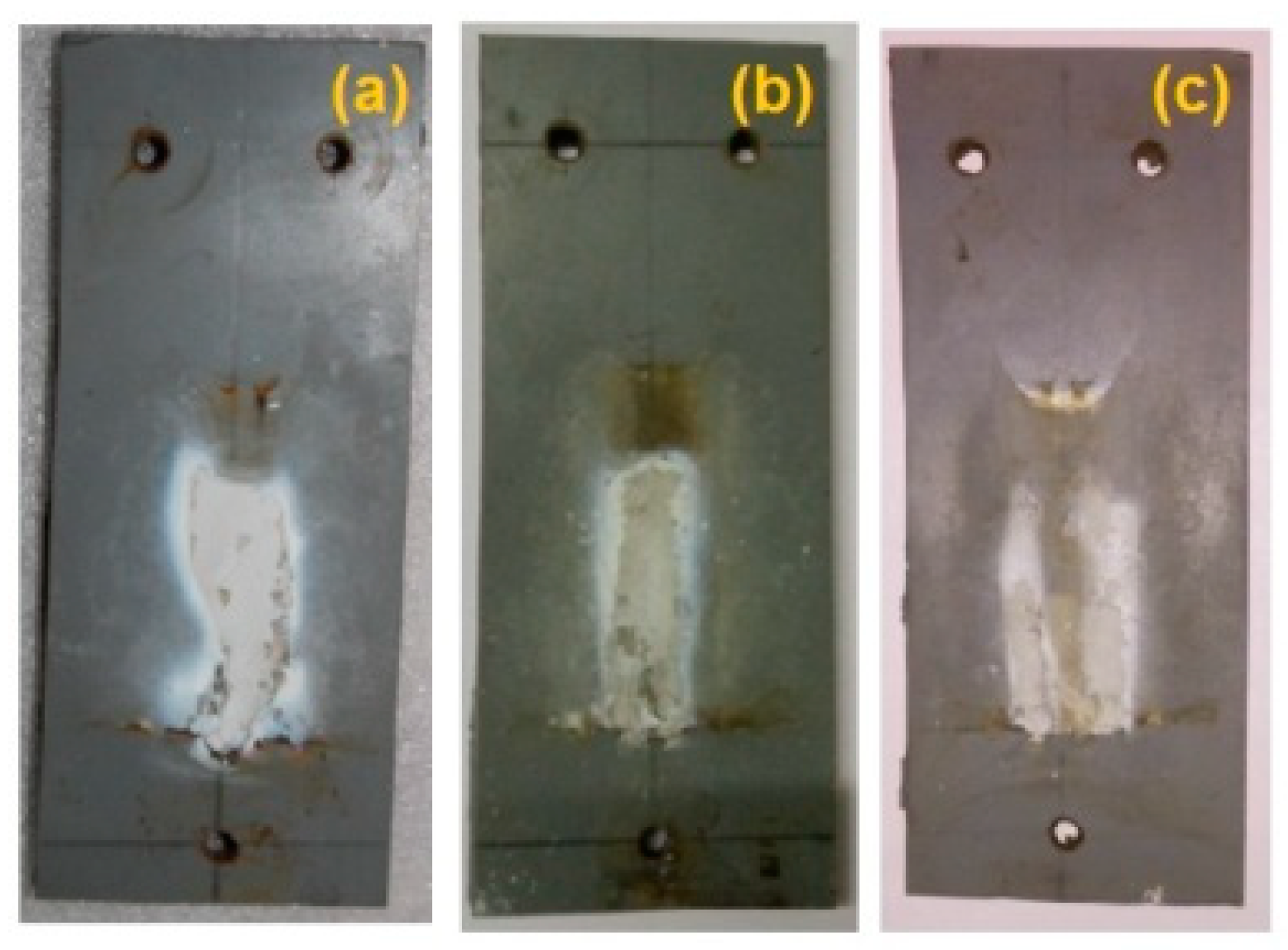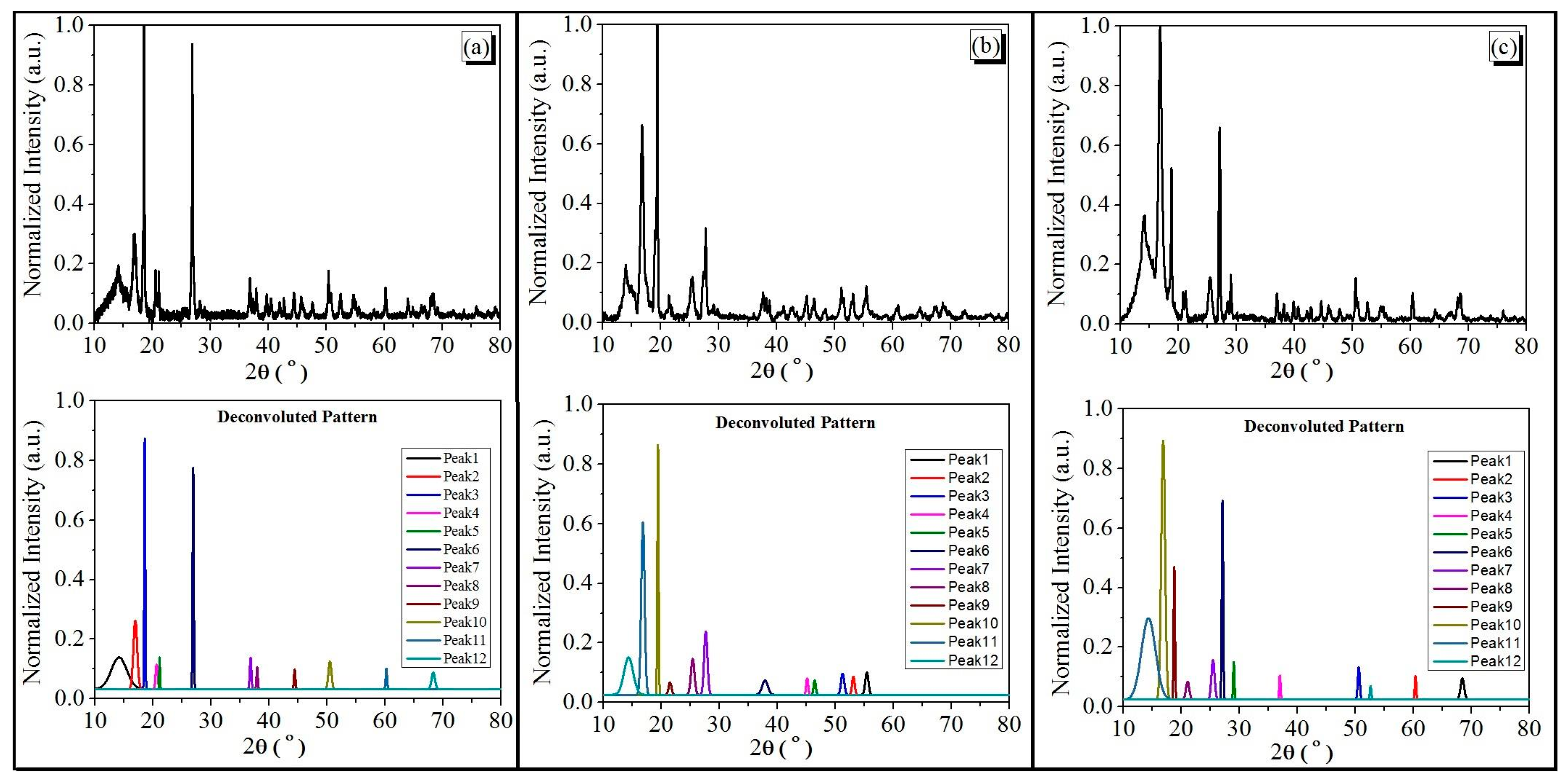1. Introduction
Polymeric insulators like Silicone Rubber (SR), High-Density Polyethylene (HDPE), Ethylene Propylene Diene Monomer (EPDM), Ethylene Propylene Rubber (EPR) and Poly Tetra Fluro Ethylene (PTFE) are used in power systems because of their superior electrical and mechanical properties over the inorganic insulators. They have less weight, superior insulation strength, higher flexibility, resistant to erosion/degradation, less chances of breakage and low installation cost.
However, there are also some disadvantages associated with polymeric insulators. Being organic in nature, they have a tendency to degrade due to environmental effects. In the presence of temperature, Ultra Violet (UV) radiation, mist, fog, and rain, the surface of the insulator in service will be affected, and it leads to the settlement of contaminants on the surface. These conducting contaminants promote leakage current, scintillation and dry-band arcing over the surface and lead to the formation of conducting tracks and permanent erosion of the materials.
As electrical discharges on the surface are more predominant in polymeric insulators due to applied electrical stress and changes in environmental conditions such as heat, rain, etc., tracking studies on them has become significant.
So far, various tracking studies have been reported in the literature on solid insulation under normal and contaminated conditions. Mathes et al. had proposed the inclined plane liquid- contaminant test [
1]. It was standardised further and IEC 60587 and American Society for Testing and Materials standard (ASTM) D2303 were developed to evaluate the resistance due to tracking and erosion of insulating material under severe ambient conditions [
2,
3]. These standards were revised in 2007 and 2013, respectively. Researchers are implementing them to study the tracking behaviour of various solid insulating materials.
The tracking effects were investigated based on the tracking length, erosion depth due to the leakage current flow and dry-band arcing over the surface of the material. The variation of leakage current magnitude, its pattern and dry-band arcing periods were considered as the parameters in the investigation. Approaches like the tracking wheel test were also employed for investigating polymeric insulation degradation under an accelerated ageing laboratory environment [
4]. Partial discharge analysis and flashover voltage tests were also carried out on polymeric insulators under clean and salt fog environments to analyse the failure mechanism with environmental stresses and were reported in literature [
5]. Multi-stress ageing effects of different types of polymeric insulators [
6,
7,
8,
9], ageing effects of HTV silicone rubber/silica hybrid composites for high-voltage insulation [
10], accelerated aging effects of silicone rubber insulators and silicone rubber-coated insulators [
11,
12], ageing of polymeric insulators under acid rain conditions [
13] and arid climatic conditions [
14] have also been reported in recent literature.
With the recent development of the High Voltage Direct Current (HVDC) transmission system, researchers have also started focussing on the DC tracking studies adapting the conventional IEC 60587 and ASTM D2303 standards of AC tracking studies. Tracking studies were also carried out on polymeric insulators under AC and DC fields and for developing some standard procedures for tracking studies on polymeric insulators. The influence of DC and AC fields on tracking was investigated based on leakage current magnitude and the erosion severity [
15,
16,
17,
18,
19].
Many methods of degradation of different types of polymeric materials have been investigated in the literature. The effect of gamma radiation ageing on silicone rubber decomposition and its electromechanical properties was investigated by Rajini et al. [
20]. The effect of gamma radiation on EPDM was investigated by Pourmand et al. [
21]. The ageing effect of radio frequency and microwave oxygen plasma on polydimethylsiloxane (PDMS) was investigated by Hillborg and Gedde [
22]. The effect of combined UV-thermal and Hydrolytic ageing on hardness, contact pressure and contact area of silicone elastomers was investigated by Wu et al. [
23]. The ageing effect in the form of algae growth over the surface of the polymeric insulators and the hydrophobicity changes have been studied by Yang et al. [
24]. The effect of thermal ageing on the formation of cross-linked structures, gamma irradiation on the oxidation of cyclic siloxane and steam exposure on molecular weight on silicone rubber was explained by Kaneko et al. [
8]. Apart from these works on polymeric insulating materials, the ageing studies on nano-composites polymeric insulators were also carried out. The effect of thermal ageing on Nano SiO
2-filled HTV silicone rubber was investigated by Loganathan et al. [
25]. The water ageing of Epoxy nanocomposite was investigated by Suchitra et al. [
26].
To get information about the degradation of the polymeric insulators, material characterization studies from the molecular level to the macro level was done using Fourier Transform Infrared (FTIR) spectroscopy, Scanning Electron Microscopy with Energy Dispersive X-ray (SEM-EDX) analysis, Differential Scanning Calorimetry (DSC), X-Ray Diffraction (XRD), Nuclear Magnetic Resonance (NMR) spectroscopy, Dielectric spectroscopy, Atomic Force Microscopy (AFM) and X-ray Photoelectron spectroscopy (XPS) [
27,
28,
29,
30,
31,
32].
It could be well seen from the literature that the focus was on a prerequisite for conducting tracking tests with good reliability. The requirement of a reliable test setup comprises of a regulated power supply, a current limiting resistor to control leakage current, dry-band arcing and erosion below the endpoint criteria during the tracking test and a controlled contaminant flow system.
The conventional high-voltage setups were found to be more costly and contained a high-voltage test transformer, high-voltage current limiting resistors and a data acquisition system. With the traditional test transformer of the high-voltage transformation ratio, it was challenging to adjust the test voltage to the required level and maintain the same throughout the test duration with proper regulation. The flow rate of the contaminant and the voltage fluctuations will significantly affect the tracking performance during the entire tracking process [
18].
The focus of this research work is to develop an indigenous low-cost electrical tracking setup with which we can perform tracking studies without voltage fluctuations. This has provided great voltage regulation compared to other tracking setups in which the conventionally available high cost, high-voltage test transformers with a high-voltage rating are used. Thus, the proposed setup addressed one of the major issues (maintaining minimum Voltage fluctuation on the High Voltage (HV) side per one voltage change on the Low Voltage (LV) side) in conducting experimentation.
In the present work, the initial focus was taken to sort out the reliability issues in carrying out high-voltage tracking tests. A simple, cost-effective, easily reproducible test circuitry for conducting the tracking test was successfully assembled and implemented. The uniform flow rate of the contaminant was achieved through the use of a simple, commercially available Intravenous (IV) system. Use of a low-voltage ratio test transformer as a source ensured a continuous regulated power supply with minimum fluctuations throughout the test duration. The resistive ladder network employed served to be effective in limiting the current below the threshold value of 60 mA, and the Digital Storage Oscilloscope (DSO) was useful in leakage current data acquisition.
Secondly, in literature, the tracking performance of insulating materials were highlighted and compared through electrical and physiochemical changes. Some literature referred to above also addressed the tracking performance of aged samples. All these research works highlight the significance of investigating the effects of ageing on hydrophobicity recovery of silicone rubber and its influence on the dynamics of degradation of the surface during the tracking period. The focus was on understanding the dynamics of the degradation process and the influence of ageing on insulation integrity.
The research focus is to mainly study the effect of environmental ageing during the tracking process of HTV silicone rubber used in outdoor insulation applications. The leakage current magnitude change for fresh and artificially aged samples were analysed to understand the effect of aging in promoting conduction over the surface of the polymeric insulators. The arcing patterns were observed for fresh and aged samples. The intensity and the frequency of arcing were observed during the tracking process. After tracking, the physicochemical properties were studied to understand the change in the crystalline nature and crystal size at the most eroded region of the sample. This gives a clear inference regarding the role of Aluminium trihydrate (ATH) filler degradation during tracking and the clustering of ATH fillers at the surface of the eroded polymer during electrical tracking.
To understand the effect of ageing on surface degradation of tracked silicone rubber samples, XRD analysis and FTIR spectroscopy studies were carried out. XRD analysis was used to gain insight about the change in the crystalline structure of the polymeric material, and FTIR analysis was used to analyse the physicochemical modifications at the surface of the tracked samples [
27,
28,
29,
30,
31,
32].
FTIR spectroscopy was mainly used to understand the changes in the fingerprint region of the spectrum due to the ageing effect. The changes in the different functional group of polymeric chain in the aged samples due to the electrical tracking failure were analysed.
The tracking studies were carried out on HTV silicone rubber samples obtained from an outdoor transmission tower polymeric composite insulator manufacturer. These HTV silicone rubbers are made up of Aluminium trihydrate (ATH)-filled polydimethylsiloxane (PDMS) to enhance mechanical, thermal and electrical erosion/tracking properties. Fresh, thermal-aged and water-aged samples were prepared and used for this study.
The samples were water-aged, and thermal-aged to emulate the effect of environmental stresses such as rain and heat on them, as per the recommendations available in the literature [
25,
26].
The investigation carried out before, during and after tracking was grouped into three stages: First, the effect of ageing on hydrophobicity was investigated. Then, the impact of ageing was investigated based on electrical and physical responses during tracking, such as leakage current, dry-band arcing, rewetting, etc. Finally, the investigation was done on the effect of ageing on physicochemical changes developed during tracking.
To assess the effect of water and thermal ageing on the hydrophobicity of samples, the contact angle measurement was carried out. A comparative study was done to understand the changes in the hydrophobicity of the samples due to ageing.
After hydrophobicity studies, all the samples were subjected to tracking investigations, and the leakage current magnitude and leakage current patterns were continuously recorded using DSO. To understand the effect of ageing on the electrical characteristics of polymeric material, the leakage current pattern and its magnitude for the water-aged and thermal-aged samples were observed and compared with that of the fresh samples.
To ensure reliability and repeatability of the results, tests were conducted on fifteen samples in total with the same experimental setup and measurement procedures, i.e., five samples each from the fresh, water-aged and thermal-aged groups were tested. The tracking tests were carried out continuously, at a constant voltage of 4.5 kV (RMS), without any power cut and fluctuations.
3. Results and Discussions
This section is divided by subheadings. It should provide a concise and precise description of the experimental results, their interpretation, as well as the experimental conclusions that can be drawn.
3.1. Influence of Ageing on Hydrophobicity
Silicone rubber possesses a good hydrophobicity and is expected to recover the same after ageing. Researchers used contact angle measurement through goniometer to measure the hydrophobicity of silicone rubber insulators before and immediately after ageing [
32]. If the contact angle is measured after allowing some time for recovery of hydrophobicity, it can give a further understanding on the hydrophobicity recovery nature of the aged silicone rubber samples and subsequently, its influence on the tracking.
In the present work, the contact angle of the fresh sample was considered as the base or reference value. The contact angle of all the five fresh samples was measured, and their average was used as a base. All the water-aged and thermal-aged samples were allowed to recover the hydrophobicity for about 24 h, and their contact angles were measured and compared with the base value for assessing the change in hydrophobicity due to ageing. The contact angles for all the fresh, thermal-aged and water- aged samples are shown in
Figure 3.
The average values of contact angle for each case were used for comparison. For the fresh samples, it was 99.91°. The fresh samples were found to be highly hydrophobic, and their average contact angle was subsequently considered as the base value during the comparison.
For thermal-aged samples, the average contact angle was 95.14°. It decreased due to thermal ageing, indicating the change from a high hydrophobic state to a low hydrophobic state. However, when the samples were aged with water, the average contact angle was only 88.00°. With the contact angle value reaching below 90.00°, it indicated that the sample had become hydrophilic. Thus, the changes in contact angle indicated that the moisture absorbing capability of silicone rubber got altered due to thermal and water ageing. This makes the investigations on the effect of ageing on the tracking of silicone rubber insulation significant.
Motivated by this, further investigations were carried out to understand the influence of thermal and water ageing of silicone rubber on various electrical aspects of tracking, such as variation in magnitude and pattern of leakage current, dry-band arcing, tracking depth and physicochemical properties such as loss of material, change in crystallinity and functional groups of silicone rubber [
27,
28,
29,
30,
31,
32].
3.2. Analysis of Leakage Current Variations During Tracking
After hydrophobicity studies, all the samples were subjected to electrical tracking studies as per the standard IEC60587. For understanding the tracking mechanism, the leakage current patterns were recorded at regular intervals. The various processes observed during tracking were summarised in three states:
Initially, during the first state, a continuous conductive moisture filament was developing over the surface of the sample. Then, Joule heating took place, evaporated the contaminant and initiated dry bands. During the second state, dry-band-stretching and elongation were observed due to the large potential difference across it. Small arcs appeared over these dry bands in the conducting filament path, thus bridging the less conductive regions of the silicone rubber surface between the electrodes. As the dry band arc path offered higher resistance than the conductive filament path, the leakage current was reduced. These reductions in leakage currents were represented by discontinuities in the leakage current patterns.
Figure 4a shows the initiation of arcing during the application of voltage.
Figure 4b shows the dry-band elongation, promoting discontinuity in arcing and leakage current. Subsequently, the voltage-drop across the dry band was increased and led to the formation of long and intensive arcs. This is shown in
Figure 4c. In the meantime, due to the continuous flow of the contaminant solution from the IV set, the surface of the specimen was rewetted, the conductive contaminant path was re-established, and the arc was quenched. Thus, in the second state, repeated arc formation and quenching though rewetting of the surface was observed. This led to the third state, which is the final stage in the tracking. During the third state, the leakage current magnitude increased slowly over time and led to carbonaceous track formation on the surface of the sample. Subsequently, the material was eroded. Continuous intense discharges were observed at this final stage with several such repetitions of rewetting and arcing, as shown in
Figure 4d.
Following this, physical observations were also made during the development of tracks: First, at initial stages, the location of dry-band arcs was slowly and continuously changing from the top electrode towards the bottom electrode and looked like a moving arc. Secondly, the initiation of the track was first observed near the bottom electrode and, as time progressed, this tracking length was increased. Thirdly, a bright localised spot appeared near the ground electrode and began to extend towards the top electrode. Finally, physicochemical changes like localised erosion and carbonisation on the surface of the material happened in the tracking path.
Further investigations on these processes and the role of potential redistributions due to rewetting and dry-band arcing during tracking can lead to a better understanding of the tracking phenomena. However, they were not considered in the scope of the present work, as the main focus is only on the role of ageing on electrical tracking of silicone rubber.
From the initial stage to the final stage, at regular intervals of time, leakage current patterns were recorded.
Figure 5 manifests the variations in the leakage current patterns of a fresh sample during the tracking test duration.
Figure 5a shows the pattern of the leakage current at the starting point. The magnitude of the leakage current was minimum, and the current was continuous. After some time, with the flow of this leakage current, the contaminant solution at the surface of the insulation was evaporated, and dry-band regions were formed. With this formation of the dry band, the leakage current pattern changed and there were discontinuities, as shown in
Figure 5b. Repeated rewetting and heavy dry-band arcing were then observed, and the current magnitude again started to increase, as shown in
Figure 5c. Subsequently, with this heavy arcing, a hotspot was witnessed near the bottom electrode, initiating erosion of the test sample near its bottom end. With time, this erosion aggravated further with simultaneous carbonisation and tracking on the surface of the material. The leakage current waveform during this continuous intense arc period is shown in
Figure 5d.
During experimentation, the leakage current patterns are almost similar for fresh, thermal-aged and water-aged samples, but the variation in the magnitude of the leakage current with time was different.
Also, the total arcing and non-arcing periods were different for fresh, thermal-aged and water-aged samples: Water-aged samples showed less non-arcing periods compared to thermal-aged and fresh samples. The intensity of arcing was higher in the case of thermal-aged samples when compared to fresh and water-aged samples.
The variation of the RMS value of the leakage current during tracking was observed continuously until the end of the test and noted every five minutes, for all the fresh, thermal-aged and water-aged samples. The RMS value for the five samples of each group was averaged and considered to represent the performance of that group.
The variation of the leakage current of fresh, thermal-aged and water-aged samples with time, during the tracking period, is shown in
Figure 6.
The plot shows an increase in the RMS values of leakage current for all three cases with respect to time. However, the following interesting observations were made regarding their dynamism, which could be significant in further understanding the effects of ageing and associated hydrophobicity changes of silicone rubber on the tracking.
For fresh samples, the leakage current magnitude increased steadily. For thermal-aged samples, the current was slightly higher than the fresh sample at the initial stage, but, at the end of the test, the highest leakage current with intense arcing was observed. For water-aged samples, the leakage current was higher from the initiation of the test and became almost constant during the last 3 h of the test.
A continuous leakage current with less arcing was observed in the case of the water-aged samples. It could be noted that the water-aged samples were found to be hydrophilic through contact angle measurement. Hence, the continuous leakage current might be due to the retained conductive contaminant layer on the surface, for an extended period.
The arcing period of the thermal-aged samples during the initial stage was more, compared to water-aged samples. Contact angles, measured earlier for these thermal-aged samples, also indicated that thermal ageing had made samples more hydrophobic. Hence, the conductive contaminant might be vaporising quickly, thereby promoting dry-band arcing.
3.3. Analysis of Tracking Length and Loss of Weight after Tracking
After six hours, which is an endpoint criterion for the tracking test, as per standard, the experiment was stopped. The specimens were removed from the sample holder and then cleaned with adequate care, to avoid any physical damage to the tested samples. The length of the tracked region was measured for all the fresh, thermal-aged and water-aged samples. One highly eroded sample from each group was selected for further investigation.
Figure 7 presents the images of such highly eroded and tracked samples from fresh, thermal-aged and water-aged groups.
The samples were weighed before and after tracking, and the percentage weight loss due to tracking was calculated.
Table 1 illustrates the comparison of the average tracking length and the average weight loss for all of the samples.
The average tracking length and average percentage weight loss of the thermal-aged and water-aged samples were comparatively higher than those of the fresh samples. The water-aged samples showed the maximum tracking length among all of the samples but the average percentage weight loss of the water-aged sample was less compared to the thermal-aged sample. The highest average tracking length was observed in the water-aged samples, and the highest average weight loss in percentage was observed in the thermal-aged samples.
With thermal stress, the bond of the polymer chain became weak. This might be the reason for the deep erosion and higher weight loss in thermal-aged samples during the tracking test.
Water-aged samples showed higher tracking length and the surface condition was affected due to loss of hydrophobicity. The erosion effect and weight loss were minimal. The role of ageing on tracked samples was further investigated through XRD and FTIR analysis. The focus was given to physicochemical changes happening in aged samples during tracking.
3.4. Analysis of Crystallinity by X-Ray Diffraction (XRD) Analysis
XRD analysis was used to explain the effect of ageing on the physical structure of the eroded polymeric insulation samples and to understand the clustering of ATH filler particles over the surface of the polymeric material during the tracking process. The highest eroded regions of the samples were cut carefully to the required dimension of 10 mm × 10 mm × 0.5 mm, and XRD analysis was carried out for the sample within the 2θ range of 10° to 90°.
Figure 8a shows the normalized XRD pattern of the fresh sample. The very low-intensity broad region from 10° to 15° indicates the amorphous nature of the silicone rubber with a low degree of crystallinity. The sharp peaks around 20° indicate the crystalline nature of the Aluminium trihydrate (ATH) filler in the polymer.
XRD analysis was then conducted on thermal-aged and water-aged silicone rubber samples. Sharpening of the amorphous hump was observed in the thermal-aged and water-aged samples. This clearly shows that the crystallinity increased due to degradation.
Figure 8b,c show the corresponding normalized XRD patterns for thermal-aged and water-aged samples.
The intensity of the peak around 18° increased considerably in the thermal-aged sample. This difference indicated that silicone rubber had become more crystalline with thermal ageing.
For the water-aged sample, higher peaks were observed at 17°, but this was comparatively less than the thermal-aged sample. These peaks confirmed that chemical changes had taken place in the samples permanently due to ageing.
In order to quantify the crystallinity, the XRD characteristics were normalized and de-convolution of XRD patterns were carried out. The percentage crystallinity was calculated using ‘Origin Pro’ software. For this, first ‘fitting of XRD peaks’ were done using the Gaussian function. Then area under crystalline peaks and the area under amorphous peaks were separately determined. The percentage crystallinity was then calculated by dividing the ‘area of crystalline peaks’ by the ‘total area of crystalline and amorphous peaks.’
The crystallinity of the fresh sample was found to be 66.04%, but for the thermal-aged sample, the crystallinity was increased to 82.82%. For the water-aged samples, it was increased to 77.05%. The variation in the percentage of crystallinity showed that the thermal-aged samples became more crystalline when compared to water-aged samples and fresh samples. Due to heat and the oxidation of the surface of the polymer, the surface material changed from amorphous to crystalline.
Using the Williamson–Hall analysis, crystal size and the strain of fresh, thermal-aged and water-aged samples were determined. The crystal size of the fresh sample was 18.1 nm with 0.1% strain. The crystal size of the thermal-aged sample was 11.6 nm with 0.1% strain. The crystal size of the water-aged sample was 11.1 nm with 0.4% strain. It is inferred that the crystal size of the eroded region of the fresh sample is higher compared to thermal-aged and water-aged samples. The reduction in the crystal size is due to the degradation of the surface layer prior to tracking studies due to accelerated ageing effects.
3.5. Fourier Transform Infrared (FTIR) Spectroscopy Analysis
FTIR spectroscopy is used to study the physicochemical changes in the material by investigating the infrared absorption spectrum. It gives the information about the presence or absence of a specific functional group of the polymeric insulation. Information about absorption or transmittance due to the O-H bond in the ATH filler, the Si-O-Si bond in the polymer chain and Si-CH
3 in the side chain of the polymer etc., can be obtained from the variations noted at different wavelengths in the IR spectra [
27,
28,
29,
30,
31,
32].
In the present work, FTIR spectroscopy of the fresh, thermal-aged and water-aged samples was carried out. The focus was on identifying the presence and absence of specific functional groups in samples when they were subjected to tracking after ageing. FTIR results were interpreted based on the similar discussion in various literatures [
27,
28,
29,
30,
31,
32].
The spectrum of the tracked fresh sample was considered as the reference.
Figure 9 depicts the FTIR spectra for tracked fresh, thermal-aged and water-aged silicone rubber samples.
In the FTIR spectrum, the region between 500 cm−1 and 1500 cm−1 is called the fingerprint region and the region between 1500 cm−1 and 4000 cm−1 is called the functional group region. In order to understand the change in the transmittance value, the FTIR spectrum was normalised, and the stacked patterns were used for better clarity.
There were distinct differences in the peaks of the spectrum of water-aged and thermal-aged samples. The dips observed in transmittance plots of all the three types of samples at 2961 and 1256 cm−1 showed an increase in the CH3 group. Corresponding transmittance values indicated that the hydrophobic recovery levels of silicone rubber samples were different for fresh and aged samples.
The water-aged sample showed a dip in the range 3500–3200 cm
−1 and indicated the decrease in the O-H stretch intensity. The continuous conduction through the contaminant had modified the behaviour surface of water-aged samples and decreased the vibration of the O-H bond of the polymeric material as well as the O-H bond of ATH fillers. This also indicated the dehydration of ATH fillers. Due to the tracking, the ATH fillers might have lost their bondage and been converted into aluminium oxide, with the evaporation of water molecules from the ATH filler, preventing surface oxidation [
31,
32]. The degree of dehydration of the water-aged sample could be inferred from the wide dip of the spectrum in this range. Carbonyl formation was also observed in this region.
Around 2961 cm−1 there was a decrease in the intensity of C-H stretch for both thermal-aged and water-aged samples. This could shrink the polymer chain, and the surface of the polymeric sample could become harder. The presence of O-H bond in water was indicated at 1641 cm−1.
In the region 1641–1412 cm
−1, there was a decrease in the peak for the water-aged sample. This could result in bending of C-H and O-H bonds and produce carbonyl degradation products. This can be attributed to the continuous leakage current on the surface of water-aged samples. After water ageing, the surface hydrophobicity decreases, and it leads to an increase in the leakage current magnitude, as discussed in
Section 3.2. This could result in the production of carbonyl degradation products.
At 1256 and 782 cm−1, the changes in the peak for the thermal-aged and water-aged sample were almost the same, and there was not much change in the intensity of the Si-C bond, the base skeleton of the polymer matrix.
In the region 1008 to 782 cm−1, there was a difference in the peak intensity of thermal-aged and water-aged samples, due to the out of plane bending of the Si-CH3 and Si-O stretch. This could reduce the Si-O rocking vibrations in the aged samples. This clearly indicates that the aging of the polymeric sample before the tracking test considerably affects the Si-CH3 and Si-O bond in the polymeric chain.
The differences observed between the IR spectra of fresh and aged samples confirmed that depolymerisation at the surface of the samples had increased with ageing.
Investigations also revealed that the formation of the hydroxyl group due to water ageing could accelerate the deterioration of polymeric material. Tracking studies on thermal-aged samples showed that the deformation in the Si-O and Si-CH3 bond had resulted in higher erosion of polymeric material.
